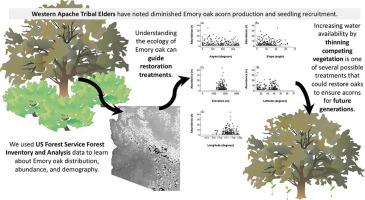Forest Ecology and Management ( IF 3.7 ) Pub Date : 2021-01-13 , DOI: 10.1016/j.foreco.2020.118900 Sara Souther , Nanebah Lyndon , Dee Randall

|
Emory oak acorns are a critically important commodity for Western Apache Tribal Nations, both as a food source and also for cultural and ceremonial uses. The Apache people historically inhabited much of Emory oak's range, but these lands are now divided among many entities, with the majority of trees occurring off-reservation in public domains. Based on observations of diminished acorn production and seedling recruitment, Apache Elders called for restoration and improved management of Emory oaks on public lands to ensure the long-term availability of acorns for Western Apache Tribes. Ecological information is critical to effectively design restoration efforts and successfully manage Emory oak, but little is known about Emory oak’s current ecological status on the landscape. Here, we use Forest Inventory and Analysis (FIA) data to examine factors that influence Emory oak distribution, abundance, and demography, and relate findings to observations made by Tribal Elders. We found that Emory oak distribution was constrained by metrics related to water availability. Drought and fire occurred frequently in Emory oak habitats, highlighting the likely importance of these disturbance events in determining oak population dynamics. Emory oak growth was predicted by environmental variables related to water availability, like physiographic class and elevation, and population characteristics, like stand age and size, but not by land ownership classifications. Interestingly, no environmental variables explained patterns of seedling recruitment and mortality perhaps owing to the stochastic nature of these events and the coarse temporal scale of FIA data in AZ. Drier, warmer conditions projected by climate models was shown to reduce future suitable Emory oak habitat, particularly in central AZ. Restoration efforts should focus on increasing water availability for Emory oaks and reducing the likelihood of high intensity fires. This could be accomplished, in part, by thinning competing vegetation at Emory oaks stands and restoring historical fire regimes. Given projections that suggest drier regional climatic patterns, strategic seed augmentation aimed at enhancing population resilience through selection of drought-adapted genotypes may also be warranted. Data were insufficient to confirm Apache Elders’ observations of diminished acorn production and seedling recruitment, highlighting the need for comprehensive demographic analyses of Emory oaks in the Southwest.
中文翻译:

洞悉埃默里橡树的恢复和可持续管理:西南文化的重点树种
埃默里(Emory)橡子是西方阿帕奇部落国家的重要重要商品,既可以作为食物来源,也可以作为文化和礼仪用途。历史上,阿帕奇族人居住在埃默里橡树的大部分土地上,但现在这些土地被划分为许多实体,其中大部分树木是在公共场所保留的。基于观察到橡子产量减少和幼苗招募的原因,Apache Elders呼吁在公共土地上恢复和改善埃默里橡树的管理,以确保西方Apache部落能够长期使用橡子。生态信息对于有效设计修复工作并成功管理埃默里橡木至关重要,但对于埃默里橡木目前在景观中的生态状况知之甚少。这里,我们使用森林清单和分析(FIA)数据检查影响Emory橡树分布,丰度和人口统计学的因素,并将发现结果与部落长老的观察结果联系起来。我们发现Emory橡树的分布受到与水供应量有关的指标的约束。埃默里橡树栖息地经常发生干旱和火灾,突显了这些干扰事件对确定橡树种群动态的重要性。埃默里橡树的生长是由与水供应相关的环境变量预测的,如生理学类别和海拔,以及种群特征,如林分年龄和大小,但不是由土地所有权分类来预测。有趣的是 没有环境变量可以解释幼苗募集和死亡的模式,这可能是由于这些事件的随机性以及AZ中FIA数据的时间尺度较粗。研究表明,气候模型预测的更干燥,更暖和的条件会减少未来合适的埃默里橡树栖息地,特别是在亚利桑那州中部。恢复工作应着重于增加Emory橡木的可用水量并减少高强度火灾的可能性。这部分可以通过在埃默里橡树林架上稀疏竞争的植被并恢复历史火灾来实现。鉴于预测表明区域气候模式较干燥,还可能需要通过选择适应干旱的基因型来增加战略种子,以增强种群的抗逆能力。











































 京公网安备 11010802027423号
京公网安备 11010802027423号